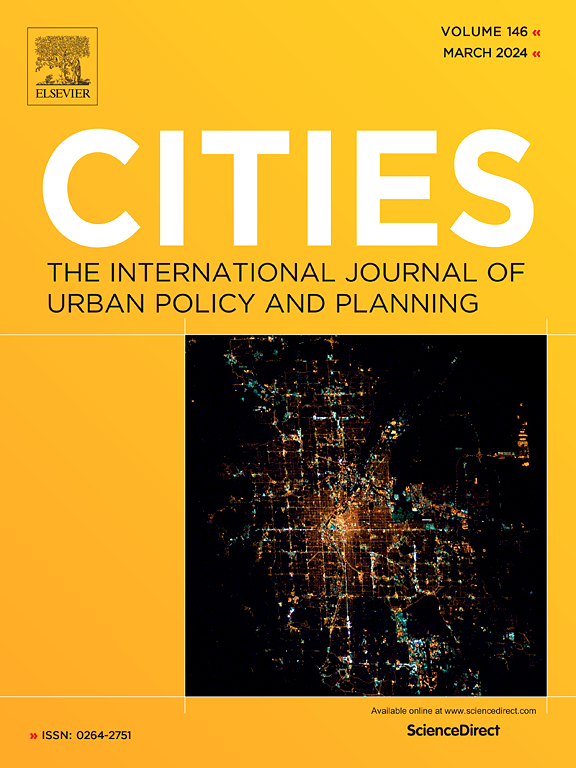为什么人们会迁移:基于区域的悉尼城市内部迁移及其与建筑环境因素的关系探索
IF 6.6
1区 经济学
Q1 URBAN STUDIES
引用次数: 0
摘要
城市内移民与城市社会空间转型密切相关,建筑环境是潜在的“推动”和“拉动”因素。然而,对于评估城市规划有效性至关重要的建筑环境在推动悉尼城市内总体移民中的作用,人们仍然没有充分了解。本研究考察了2006年至2021年悉尼的城市内移民模式,并应用重力模型和多尺度地理加权回归(MGWR)模型,在考虑空间差异的同时,识别与建筑环境相关的推拉因素。研究结果表明:(1)悉尼城区内移民加剧,尤其是西部地区。(2)目的地充足的住房、更多的独立住宅和较少的非私人住房激励了人口流入,而这些相同的属性在原籍地阻碍了人口流出。观察到移民驱动因素的空间差异:独立式住房阻碍了短距离的流入,但促进了长距离的流入。从西向东迁移的人倾向于迁移到独立住宅较少但自有住房较多的地区,而向西迁移的人则表现出相反的趋势。学校与迁移之间的关系也表现出东西空间差异,这可能与西部较低的教育质量有关。该研究建议,城市政府考虑差异化的空间住房市场,以满足不同的需求,并加大力度提高西部城市基础设施的质量,以解决空间不平等问题。这些发现有助于更好地理解城市内部迁移的空间异质性推拉框架下的建筑环境因素,为快速转型的大都市地区优化城市基础设施规划和人口(再)分布提供有价值的见解。本文章由计算机程序翻译,如有差异,请以英文原文为准。
Why do people move: An area-based exploration of intra-urban migration in Sydney and its relationship with built environment factors
Intra-urban migration is closely linked to urban socio-spatial transformation, with built environments acting as potential “push” and “pull” factors. However, the role of built environments in driving aggregate-level intra-urban migration in Sydney, which is crucial for assessing urban planning effectiveness, remains insufficiently understood. This study examines Sydney's intra-urban migration patterns from 2006 to 2021 and applies the gravity model and Multiscale Geographically Weighted Regression (MGWR) model to identify built-environment-related push and pull factors while accounting for spatial variance. The findings reveal that: (1) Intra-urban migration intensified in Sydney, particularly in the west. (2) Sufficient housing, more detached dwellings, and less non-private housing in the destination incentivized population inflows, while these same attributes at the origin discouraged outflows. Spatial variations in migration drivers were observed: detached housing discouraged short-distance inflows but promoted long-distance inflows. West-to-east movers tended to relocate to areas with fewer detached homes but more owner-occupied housing, while westward movers displayed an opposite trend. The relationship between schools and relocation also exhibited east-west spatial variance, potentially linked to the lower quality of education in the west. The study suggests that the city government consider a differentiated spatial housing market to meet different needs and enhance efforts to improve the quality of urban infrastructure in the west to address spatial inequality. These findings contribute to a better understanding of built environment factors within the push-pull framework of intra-urban migration concerning spatial heterogeneity, providing valuable insights for optimizing urban infrastructure planning and population (re)distribution in rapidly transforming metropolitan areas.
求助全文
通过发布文献求助,成功后即可免费获取论文全文。
去求助
来源期刊

Cities
URBAN STUDIES-
CiteScore
11.20
自引率
9.00%
发文量
517
期刊介绍:
Cities offers a comprehensive range of articles on all aspects of urban policy. It provides an international and interdisciplinary platform for the exchange of ideas and information between urban planners and policy makers from national and local government, non-government organizations, academia and consultancy. The primary aims of the journal are to analyse and assess past and present urban development and management as a reflection of effective, ineffective and non-existent planning policies; and the promotion of the implementation of appropriate urban policies in both the developed and the developing world.
 求助内容:
求助内容: 应助结果提醒方式:
应助结果提醒方式:


